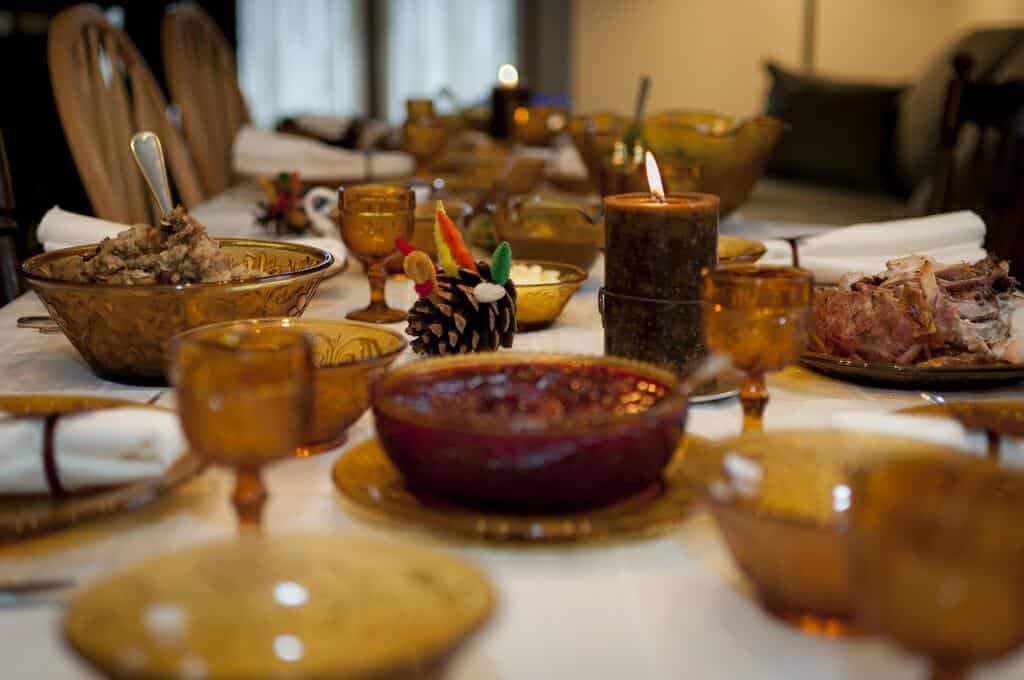MRS. HOWELL: But sugar beets come in cans!
GILLIGAN: No, no. First you have to plant them in the ground.
MRS. HOWELL: Oh, please, don’t be silly. I’ve seen them in their natural habitat, a Super Market.
—Gilligan’s Island, “Pass the Vegetables Please” (1966)
God our Maker doth provide . . . .
—Henry Alford, “Come Ye Thankful People, Come” (1844)
Where the Food Grows
In 2017 in the United States, some 3 million farmers operate 2.1 million farms that cover 911 million acres of land. These farmers make up only 2 percent of the United States’ population. Farmland in general makes up roughly 40 percent of the United States, but this count includes woodlands and pastureland. Our farmlands and our farmers feed this nation. As I write this, I’m looking out over some of the most productive farmland in the world: Mississippi silt-loam bottom land.
But most Americans are not farmers. Further, few of us have spent any time on a real farm. Most have no conception of the agricultural seasons. We can’t tell planting times from harvest. We see the rain and the sun, but we rarely consider their effects on the future availability or price of food. For the most part, as Americans, we really don’t understand where food comes from or farm life, for that matter … calloused hands, the relentless hours, frustrating weather, vanishing profit margins, the psychological pressure to make payments on land and equipment. (And then hope there’s some left after the harvest is in.) The problem is … we romantically equate farm life with what we’ve seen on television, most of which has been highly stylized.
So we get our food from local supermarkets or from a discount warehouse. We expect to find our corn or eggs or beef there on the shelves, rain or shine. Or if we buy our food online, we expect it at our doorstep in two days if we have Prime. The whole farm-to-table food process seems almost invisible, irrelevant and yet as certain and predictable as the workings of a well-run machine. (Or kind of like DOS running silently in the background of a computer.)
As a consequence of all this, most Americans don’t understand how important the concept of harvest festivals are.
Israel’s Harvest Festivals
Under the Mosaic Covenant, God established two harvest feasts for Israel and one other festival day tied to harvest. Let’s take a look:
On the first day after the Passover Sabbath, Israel was to wave a sheaf of barley before the Lord … that is, at the altar in the Tabernacle or, later, in the Temple (Lev. 23:9-14). This sheaf was to come from the first field that produced ripened barley. The sheaf was to be accompanied by an ascension offering, an unblemished lamb of the first year, a tribute offering of barley flour mingled with oil, and a drink offering of wine. Until the offering of this sheaf, no one in Israel was to eat bread, parched grain, or green ears of grain from the new crop. The first of the first belonged to God.
Put God Back Into History And Teach Your Kids What They Won’t Learn Anywhere Else!
Beginning with the waving of the first fruit sheaf, Israel was to count seven sabbaths or weeks (Lev. 23:15-21). The day after, the first day of the next week, was the first true harvest festival. Like the day before it, it was a Sabbath … a day of worship and rest. Scripture calls this festival Pentecost (the 50th day), the feast of weeks (seven weeks after Passover), or simply Firstfruits. Now the barley harvest was finished, and the wheat harvest was well underway. The Pentecost offering consisted of two loaves of bread with an ascension offering of seven lambs, one bullock, and two rams together with their grain and wine offerings. These were to be followed by a kid of the goats as a purification offering and two lambs as a peace offering. In addition to these formal sacrifices, God’s people were to bring freewill offerings to the Lord (Deut. 16:9-11).
The final harvest festival fell at the end of grape harvest (Lev. 23:33-36). It was called Booths, or Tabernacles, or Ingathering. It began on the 15th day of the seventh month, the last month of the liturgical cycle. It began with sabbath worship and ended with sabbath worship, so it lasted eight days. Throughout the feast, Israel was to offer bullocks daily … 13 on the first day, 12 on the second, and so on down to seven on the seventh day, plus one more on the eighth (Num. 29:12-38). The total was 70 + 1: seventy sacrifices for the nations of the world plus one for Israel. With all of these came two rams and 14 lambs each day, all with their grain and wine offerings.
In addition to offering sacrifices, Israel was to make booths out of tree branches and camp out of doors throughout the whole feast. This was to remind Israel that her ancestors dwelt in booths under the shadow of the glory cloud when God brought them out of Egypt (Lev. 23:43). This was the time for God’s people to bring their tithes to the Tabernacle or Temple. Interestingly, God commanded them to use some of that tithe money for their own celebrations: “And thou shalt bestow that money for whatsoever thy soul lusteth after, for oxen, or for sheep, or for wine, or for strong drink, or for whatsoever thy soul desireth: and thou shalt eat there before the LORD thy God, and thou shalt rejoice, thou, and thine household, and the Levite that is within thy gates” (Deut. 14:26ff).
What’s Going On Here? What’s God Purpose In All This?
Their implications for theology and sociology are very broad. These are the details. Here are just a few:
1) The harvest festivals were to remind Israel that Nature is not a machine. There are no natural laws or forces that govern the universe. God governs the universe, directly and personally. He sends the rains; He makes the grass to grow (Ps. 104:14, 147:8; Acts 14:17). At the same, time God uses secondary causes (and providentially upholds those causes) to accomplish His purposes. He gives or withholds His blessings from men’s labors (Deut. 8:11-18). He blesses the harvest or curses it. God expects His people to recognize His providence in all of this … to be firmly convinced that “herbs and grass, rain and drought, fruitful and barren years, meat and drink, health and sickness, riches and poverty, yea, all things come not by chance, but by His Fatherly hand.”
2) Israel’s harvest festivals were, therefore, a time for Israel to rejoice in God’s blessings (Deut. 16:15). They were an occasion for joy and gladness. They were a set time for Israel to thank God formally for His gracious provision. Such thanksgiving was an explicit rejection of Canaanite Nature worship (the cults of Baal and Ashtoreth) and an affirmation of Israel’s covenant relationship with the personal Creator God.
3) Israel’s thanksgiving was to include formal worship, prayer and praise, material gifts to God, a break from work, communal feasting, commemoration of God’s great works, and charity to those in need. Nothing here is contrary to the commands or spirit of the New Covenant.
4) The feasts were encouragements to charity. God reminded His people to include their pastors (Levites), their servants, and “the stranger, and the fatherless, and the widow” in their festivities (Deut. 16:11, 14). And right in the middle of the Levitical instructions for Pentecost is the gleaning law: “And when ye reap the harvest of your land, thou shalt not make clean riddance of the corners of thy field when thou reapest, neither shalt thou gather any gleaning of thy harvest: Thou shalt leave them unto the poor, and to the stranger: I am the LORD your God” (Lev. 23:22). Material prosperity was not to obscure the needs of the poor but rather to highlight them. Harvest time was to be a sort of “boon” to all of God’s people.
5) The harvest festivals tied Israel’s agricultural life into some remarkable themes within redemptive history: All of the harvest festivals pointed forward to the coming Messiah. They were all Christ-centered.
The waving of the first-fruit sheaf took place on the Sunday after the Passover Sabbath … that is, on the day Jesus rose from the dead as the Firstfruits of the new creation (1 Cor. 15:20, 23; Col. 1:18; Rev. 1:5). Pentecost looked forward to the outpouring of the Holy Spirit that followed Jesus’ resurrection and ascension and to the initial harvest of Israel (Acts 2; Rev. 7:1-8 with 14:4). And Tabernacles looked forward to the harvest of the Gentiles that began with the worldwide preaching of the Gospel and will climax in the final Resurrection when Jesus returns (Zech. 14:16-21; Matt. 13:39; Mark 4:29).
Seedtime and harvest pointed Israel … and should point us … beyond the present to glorious victory of God’s Kingdom within history and beyond. As in the Lord’s Prayer, our daily bread and the Gospel of forgiveness should go hand in hand as the outworking of the coming of Messiah’s Kingdom (Matt. 6:10-12).
Conclusion
The New Testament doesn’t tell us to celebrate any specific day as Thanksgiving. It does insist that thanksgiving is to be a way of life for God’s people (Col 3:15-17; Eph. 5:20; 1 Thes. 5:18; Heb. 13:15). Our American Thanksgiving has obviously become secularized. Even its nickname sticks in the throats of the worldly: They call it “Turkey Day.” But not just that … the real celebration and worship comes the following day on Black Friday when the chaos gods are awakened.
This in itself is no reason for God’s people to refrain from celebration, feasting, or most especially thanksgiving. But God’s chief concern is always the condition of our hearts. The truth is … biblical thanksgiving should never stay bottled up in our hearts. It should break out in prayer and song, joy and exuberance, communal celebration, and charity.
 Off The Grid News Better Ideas For Off The Grid Living
Off The Grid News Better Ideas For Off The Grid Living






